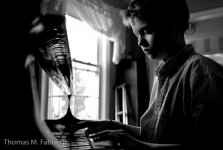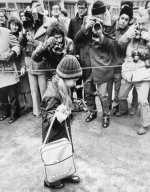Bill Pierce
Well-known
In the thread preceding this, David Seelig wrote, "I use both dslrs and my m8 my lone 35 film camera left is an m6. Most of my own work is with an m8 most pro work with my canons dslr though after getting a canon 5d mk 11 leica needs to seriousily upgrade the m8 or come out with an m9 already."
I find this is pretty much the response of most of the professionals I know who use both DRF and DSLR. The film rangefinder was the dim light king offering accurate wide open focus with high speed normal and wide angles, the tools of the dim light trade - especially with films like Kodak's P3200.
Film Leicas were relatively quiet and small, often advantages in situations that called for you to work discreetly in the world of available darkeness.
The larger, noisier M8 still had the advantage of sometimes providing better wide open focusing accuracy in dim, low contrast situations. And it was still smaller than the big professional DSLR's.
But the remarkable high ISO performance of the new Canon and Nikon DSLR's makes shooting in the available darkness, and producing breathtaking results, even with relatively slow f/2.8 zooms, a piece of cake.
In the digital world of dim light, the Leica is no longer king. In the film world I think it is.
Two questions -
(1) Journalism is now essentially digital. Is the rangefinder, a major tool of photojournalists and documentarians in the past, going to survive as such in the digital world?
(2) Equally important - in what arenas does the digital M8 shine as brightly as its film predecessors?
I find this is pretty much the response of most of the professionals I know who use both DRF and DSLR. The film rangefinder was the dim light king offering accurate wide open focus with high speed normal and wide angles, the tools of the dim light trade - especially with films like Kodak's P3200.
Film Leicas were relatively quiet and small, often advantages in situations that called for you to work discreetly in the world of available darkeness.
The larger, noisier M8 still had the advantage of sometimes providing better wide open focusing accuracy in dim, low contrast situations. And it was still smaller than the big professional DSLR's.
But the remarkable high ISO performance of the new Canon and Nikon DSLR's makes shooting in the available darkness, and producing breathtaking results, even with relatively slow f/2.8 zooms, a piece of cake.
In the digital world of dim light, the Leica is no longer king. In the film world I think it is.
Two questions -
(1) Journalism is now essentially digital. Is the rangefinder, a major tool of photojournalists and documentarians in the past, going to survive as such in the digital world?
(2) Equally important - in what arenas does the digital M8 shine as brightly as its film predecessors?



